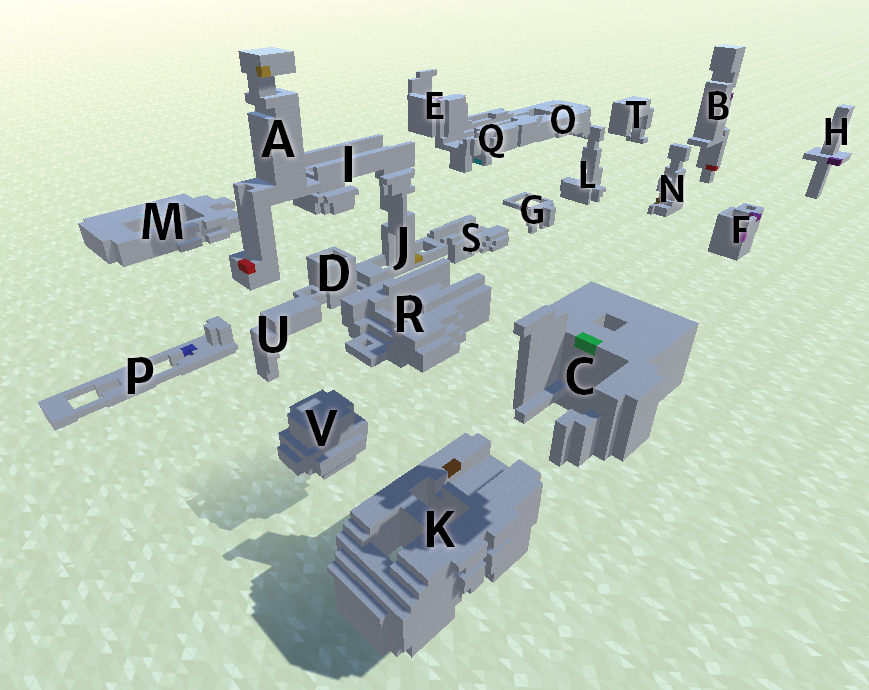Goliath's Goof
by Wei-Hwa Huang (puzzle design and making demands of Yar), Yar Woo (programming and implementation)
Answer: MIGUEL BERROCAL
The flavor text strongly suggests that the solver should assemble the pieces into one single sculpture. To help with this, most of the pieces have a few colored voxels (like a pixel, but in 3D). There are 8 voxels in each of 8 colors: red, green, magenta, violet, orange, cyan, brown, blue, and each set of voxels of the same color must touch in a 2x2x2 cube. This is hinted at by the flavor text talking about fragments of gemstones.
To more easily continue with the solution, we'll label the pieces with letters from A through V, in approximately the order in which they should be assembled:

Here's a table of each colored "gem" and the pieces it is in:
| Color | Pieces |
|---|---|
| red | square base (look inside the hole), A, B |
| green | C, D, I (visible from below) |
| magenta | E, F, I (visible from below) |
| violet | B, F, G, H |
| orange | A, J, K (visible from below) |
| cyan | L, M, O, Q |
| brown | K, M, N |
| blue | N, P, R |
By connecting the gemstones, the solver should be able to assemble all the pieces from A through R. This leaves the remaining pieces S, T, U, V for the solver to assemble themselves.
For the most part, pieces can be assembled by just moving downward from above into the correct position, as long as they are done in order. There are a few exceptions, as detailed below:
- G has to slide in from the front.
- J has to slide right after going down.
- M has to slide forward after going down.
- N has to come in from the side (unless M hasn't been placed yet).
- O can't go down all the way unless N is moved to the right of its correct place by two voxels; after going down, both it and N need to slide left together.
- Sliding P into Q will make it easier to put both pieces down as a unit.
- T won't go in unless P is moved to the right of its correct place by three voxels.
- U won't go in unless P is moved to the right of its correct place by two or three voxels.
- V won't fit unless P is in its correct place.
A full video of the assembly (with comments in subtitles) can be seen here.
A spreadsheet of the assembled statue with all pieces identified is here.
Another possible way to learn the assembly is to realize that the puzzle is based on an actual 1969 puzzle called Mini David; the sequencing of the pieces is nearly identical. (The puzzle was a limited run of 9500, is highly sought after by collectors, and has an estimated value of $3000, so we're not expecting many teams to go this route.)
After assembling, the sculpture turns gold and a plaque appears on the base, with the text:
"Cubist" Mini David with apologies to _ _ _ _ _ _ _ _ _ _ _ _ _ _
The blanks suggest they should be filled in with the name of the original designer of Mini David, which for those who do not know, will have to do some web-searching to find. This gives the correct answer: the Spanish sculptor MIGUEL BERROCAL.
Some easter eggs in the flavor text/story: Goliath was David's nemesis in the Bible, and the "King of the Wild Fronter" was a name for David "Davy" Crockett. The first letters of each sentence spell out TORSO, which is what the sculpture represents.
Thanks to Nick Baxter and Brett Kuehner for some brainstorming that eventually led to this puzzle.
